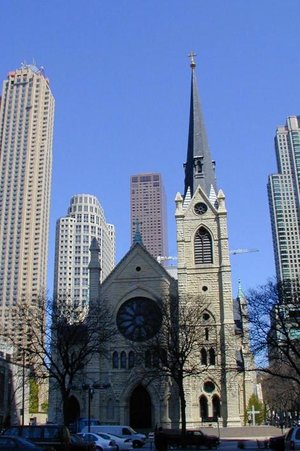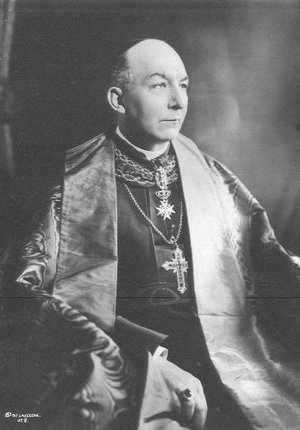Holy Name Cathedral
|
|
Holy Name Cathedral, formally the Cathedral of the Holy Name, is the seat of the Roman Catholic Archdiocese of Chicago, one of the largest Roman Catholic dioceses in the United States. It is also the parish church of the Archbishop of Chicago. Located in Chicago, Illinois in the United States, Holy Name Cathedral replaced the Cathedral of Saint Mary and the Church of the Holy Name, both destroyed by the Great Chicago Fire in October 1871. The cathedral was finally dedicated on November 21, 1875.
| Contents |
|
|
Architecture and furnishings
Holy Name Cathedral was built in the Gothic revival architectural style while at the same time integrating motifs symbolic of the message of the modern Church. The church building is 233 feet long, 126 feet wide and can seat 1520 people. The ceiling is 70 feet high and has a spire that reaches 210 feet into the sky. Overall, the cathedral features motifs meant to instill an ambience of physically dwelling in the biblical "Tree of Life."
ResurrectionCrucifixHolyNameCathedral.jpg
Bronze cathedral doors
The first feature that greets worshipers are massive bronze doors designed by Albert J. Friscia that weigh 1200 pounds each. The doors introduce the overall "Tree of Life" theme with intricate details that serve to make the doors look like overwhelming planks of wood. Beyond the doors is a vestibule encased in glass.
Resurrection crucifix
Once inside the church, the most striking feature is the suspended Resurrection Crucifix sculpted by the artist Ivo Demetz. A Resurrection Crucifix was preferred, as opposed to the more common Agony Crucifix of the dying Christ, in recognition of the importance of the Easter story in the actual birth of Christianity as a religion. Adorning the walls of the nave are the Stations of the Cross by artist Goffredo Verginelli depicting the Passion, Crucifixion and Resurrection of Christ. The stations are cast in bronze and framed in red Rocco Alicante marble.
Ambo of the Evangelists
Various bronze sculptures are featured in other parts of the church. One of the largest pieces is the Ambo of the Evangelists by Eugenio de Courten. An ambo, in church liturgy, is the lectern from which readings of Holy Scripture are proclaimed. The bronze casting depicts the authors of the Gospels with their symbols: Matthew the angel representing the Gospel of the Church; Mark, the lion and inspiration for Peter’s teachings or catechesis; Luke, the ox, for his recounting of Christ’s infancy; John, the eagle, for the writer of the Spiritual Gospel, recounting the story of "the Word made flesh."
Ambo of the Epistle Writers
Also by de Courten is the Ambo of the Evangelists, a bronze casting depicting the authors of the apostolic letters to the early Church communities: Peter, with keys to the Kingdom of God; Paul, who died by the sword; James, representing faith sustained by good works; and Jude, carrying a whip representing correction. This particular ambo is used by lectors and cantors during Sunday masses and other special Church feasts and memorials.
Cathedral altar
Holynamecathedralemptyinterior.jpg
Six tons of monolithic red-black Rosso Imperiale di Solberga granite forms the mensa or table top of the altar. The pedestal is encircled by a bronze bas-relief depicting Old Testament scenes of sacrificial offerings and preparation: Abel's offering of the first sacrifice, the priest Melchizedek giving bread and wine, Abraham's willingness to sacrifice his son Isaac, and the Prophet Elijah receiving bread and water from the Angel of the Lord for strength to continue on his journey. The consecrated altar contains relics, or actual artifacts from the bodies of Saint John the Apostle and Saint Timothy.
Cathedra of the See of Chicago
A cathedra, or bishop's throne, is what makes the church a cathedral. It is from this chair that Sede Chicagiensis, or See of Chicago, is presided over by the archbishop of Chicago. Unlike most Roman Catholic cathedra, the Cathedra of the See of Chicago is plain and simple. Its back contains three panels depicting the first Christian teachers: Christ in the center panel, and Saint Peter to his left and Saint Paul to his right.
Sanctuary Panels of the Holy Name
Above the cathedra are the Sanctuary Panels of the Holy Name, five bronze panels by Attilio Selva representing the Holy Name of Jesus from which the church gets its name. The first panel is of Simeon contemplating the Infant Savior whom Mary presents in the Temple. The second panel depicts the Mystery of the Trinity and an angel carrying the monogram of Christ to earth. The third panel is of the Risen Christ proclaimed as Lord. The fourth panel is of the Presentation of Jesus in the Temple showing Mary and Joseph presenting the child for circumcision and naming. The last panel is of the Priesthood of Jesus, with Christ adorned in vestments presenting the chalice to all people.
Galeros of the Cardinals
Despite its ban by the Second Vatican Council, the popes have made exceptions for the Archdiocese of Chicago in the granting of the galero, a wide-brimmed tasseled scarlet hat, to its cardinals in consistory. Galeros are specially commissioned by the Vatican for future archbishops of Chicago that are created cardinal.
Holy Name Cathedral continues the tradition of raising the galero of a deceased cardinal over the cathedra from the highest point of the semicircular, domed cathedral apse. The galero is hung forever over the congregants of Holy Name Cathedral where they remain until they are reduced to dust, symbolizing how all earthly glory is passing. Looking up above the Cathedra of the See of Chicago are the galeros of, from left to right, Cardinals Meyer, Bernardin, Mundelein, Cody and Stritch.
Great Chicago fire of 1871
At the time of the founding of the Diocese of Chicago on September 30, 1843, Bishop William Quarter led his faithful from the Cathedral of Saint Mary at the southwest corner of Madison and Wabash Streets. A few years later in 1851, an immense brick church called the Church of the Holy Name was being constructed on State Street between Huron and Superior streets. Its cornerstone was set in 1852. In October of 1871 however, both churches were destroyed as the Great Chicago Fire engulfed all of the city. Church of the Holy Name pastor John McMullen travelled the country to raise funds to rebuild the churches and to aid the homeless of Chicago. Meanwhile, Chicago's Catholics were forced to worship in what was called the shanty cathedral, a boarded-up burnt house on Cass Street. They worshiped there for over four years.
Breaking ground for the new cathedral
In 1874, Brooklyn architect Patrick Charles Keely was selected to design the new cathedral of Chicago. On July 19 of that year, the cornerstone was finally laid. On November 21 of the following year, Bishop Thomas Foley dedicated the church and christened it the Cathedral of the Holy Name. In 1880, the Diocese of Chicago was reorganized to become the Archdiocese of Chicago and Holy Name Cathedral became the church of primacy over several other dioceses in the Midwest United States.
Early renovations
In 1888, surveyors noticed that the cathedral was sagging on its Superior Street side. The prompted the archbishop to commence with the cathedral's first renovation projects. By 1915, Holy Name Cathedral was balanced out and saved from sinking into the ground. It was also lengthened by 15 feet to accommodate the growing Catholic population. That same year, James Edward Quigley, Archbishop of Chicago, died. The first major mass of the newly rededicated cathedral was the late archbishop's funeral.
George Cardinal Mundelein
In 1924, Archbishop George W. Mundelein was elevated by the pope to become a cardinal. When he returned from consistory at the Vatican, the new cardinal was greeted at Holy Name Cathedral with a celebratory procession of over 80,000 Catholics. Cardinal Mundelein gained new followers and became a beloved pastoral leader.
When Cardinal Mundelein died unexpectedly in his sleep in October 1939, Chicago City Hall hastily paved State Street where the subway was being constructed to accommodate the great influx of mourners expected to make the pilgrimage. As Cardinal Mundelein lay in state in the nave of Holy Name Cathedral, over a million people paid their last respects.
Second Vatican Council
As soon as the Second Vatican Council was concluded in the 1960s, Holy Name Cathedral proceeded with a massive renovation project to alter the cathedral interior to meet the demands of new liturgical rules. From Easter 1968 to 1969, Holy Name Cathedral was closed and masses were held in various locations including a nearby school gymnasium. At midnight on Christmas Eve of 1969, Holy Name Cathedral was reopened and the first English language mass was celebrated with the presider actually facing the congregation for the first time.
Papal Visit of 1979
Pope John Paul II became the first Pontiff to preside over Holy Name Cathedral in October 1979. On two successive evenings, Pope John Paul II was treated to the music of Luciano Pavarotti and the Chicago Symphony Orchestra in the nave of the cathedral.
Joseph Cardinal Bernardin
Holynamecathedralmass.jpg
As soon as Cincinnati Archbishop Joseph Bernardin became archbishop of Chicago and was created cardinal, Holy Name Cathedral became known as the home of one of the most beloved cardinals in American Catholic Church history. Cardinal Bernardin was an outspoken prelate and traveled the country to speak on behalf of many social justice issues. He even traveled the world to speak to the faithful overseas. On November 14, 1996, Cardinal Bernardin died after losing a battle with cancer. Not since the visitation of Cardinal Mundelein did so many people come to the side of the cardinal's body as it lay in state. Millions paid tribute during his funeral mass.
Resources
- Archdiocese of Chicago (http://www.archdiocese-chgo.org/)
- Holy Name Cathedral (http://www.holynamecathedral.org/menu.htm)



